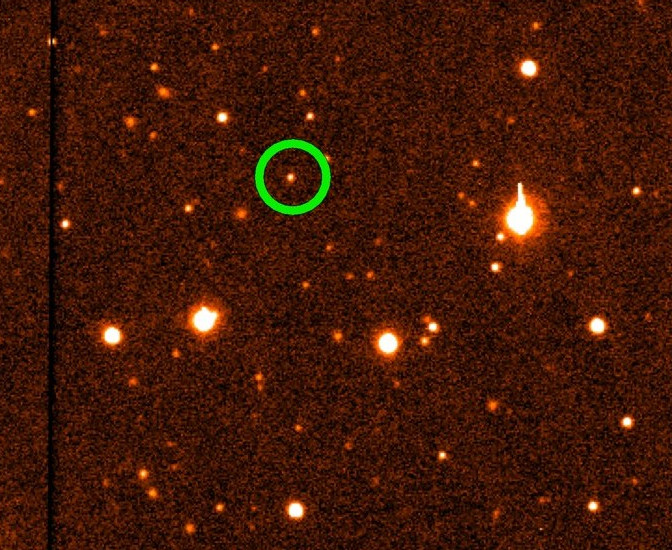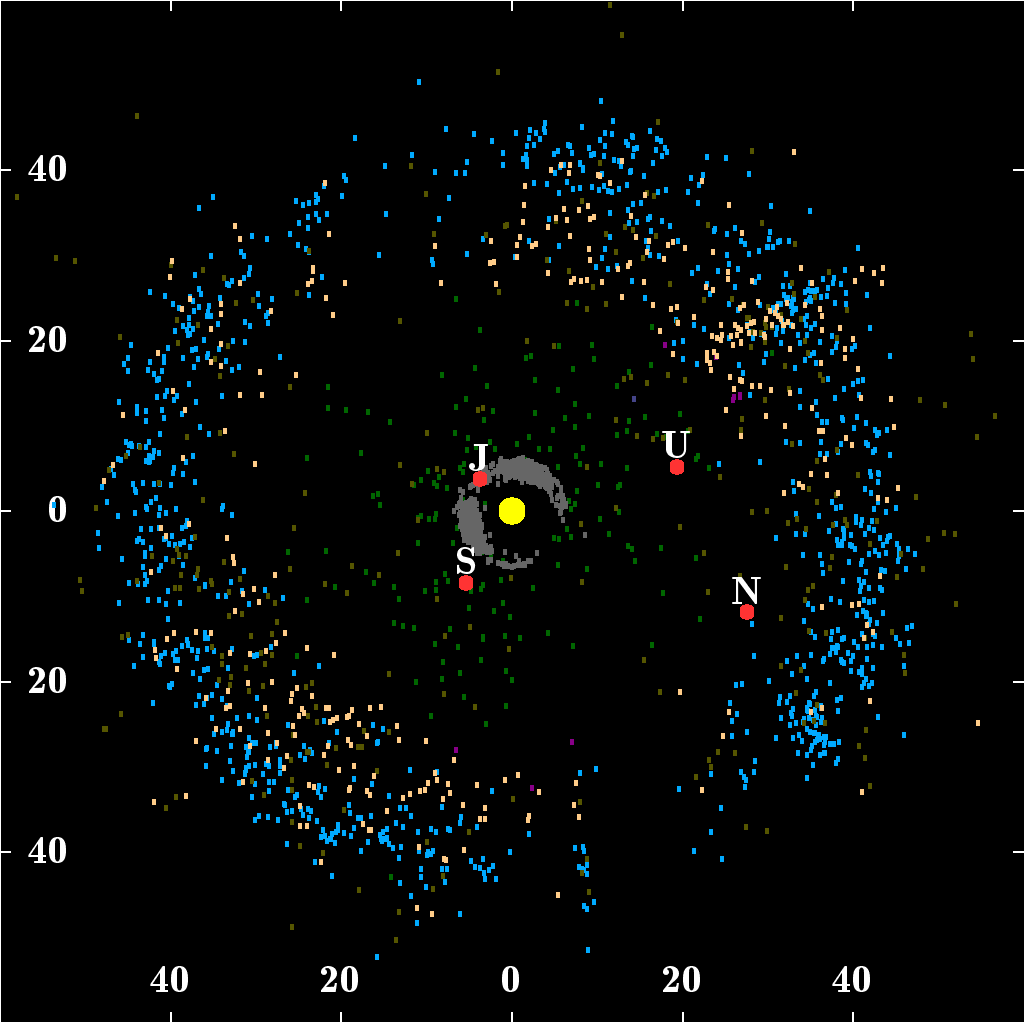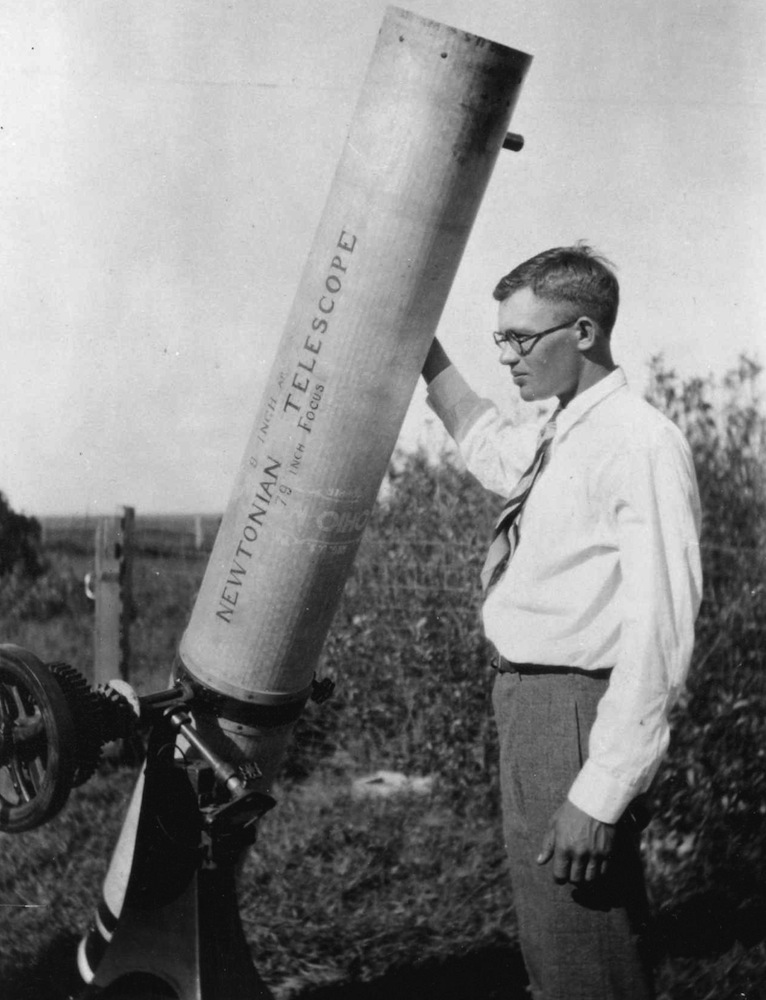|
90482
Orcus (minor-planet designation: 90482 Orcus) is a dwarf planet located in the Kuiper belt, with one large moon, Vanth. It has an estimated diameter of , comparable to the Inner Solar System dwarf planet Ceres. The surface of Orcus is relatively bright with albedo reaching 23 percent, neutral in color, and rich in water ice. The ice is predominantly in crystalline form, which may be related to past cryovolcanic activity. Other compounds like methane or ammonia may also be present on its surface. Orcus was discovered by American astronomers Michael Brown, Chad Trujillo, and David Rabinowitz on 17 February 2004. Orcus is a plutino, a trans-Neptunian object that is locked in a 2:3 orbital resonance with the ice giant Neptune, making two revolutions around the Sun to every three of Neptune's. This is much like Pluto, except that the phase of Orcus's orbit is opposite to Pluto's: Orcus is at aphelion (most recently in 2019) around when Pluto is at perihelion (most recently in 1989) ... [...More Info...] [...Related Items...] OR: [Wikipedia] [Google] [Baidu] |
Vanth (moon)
Vanth (formal designation (90482) Orcus I; provisional designation S/2005 (90482) 1) is a natural satellite or moon of the large trans-Neptunian dwarf planet Orcus. It was discovered by Michael Brown and Terry-Ann Suer using images taken by the Hubble Space Telescope on 13 November 2005. The moon has a diameter of , making it about half the size of Orcus and the third-largest moon of a trans-Neptunian object. Vanth is massive enough that it shifts the barycenter of the Orcus–Vanth system outside of Orcus, forming a binary system in which the two bodies revolve around the barycenter, much like the Pluto– Charon system. It is hypothesized that both systems formed similarly, most likely by a giant impact early in the Solar System's history. Compared to Orcus, Vanth has a darker and slightly redder surface that supposedly lacks exposed water ice, resembling primordial Kuiper belt objects. Discovery Vanth was discovered in Hubble Space Telescope images taken on 13 Novemb ... [...More Info...] [...Related Items...] OR: [Wikipedia] [Google] [Baidu] |
Inner Solar System
The Solar SystemCapitalization of the name varies. The International Astronomical Union, the authoritative body regarding astronomical nomenclature, specifies capitalizing the names of all individual astronomical objects but uses mixed "Solar System" and "solar system" structures in theinaming guidelines document. The name is commonly rendered in lower case ('solar system'), as, for example, in the ''Oxford English Dictionary'' an''Merriam-Webster's 11th Collegiate Dictionary''. is the gravitationally bound system of the Sun and the objects that orbit it. It formed about 4.6 billion years ago when a dense region of a molecular cloud collapsed, forming the Sun and a protoplanetary disc. The Sun is a typical star that maintains a balanced equilibrium by the fusion of hydrogen into helium at its core, releasing this energy from its outer photosphere. Astronomers classify it as a G-type main-sequence star. The largest objects that orbit the Sun are the eight planets ... [...More Info...] [...Related Items...] OR: [Wikipedia] [Google] [Baidu] |
Plutino
In astronomy, the plutinos are a dynamical group of trans-Neptunian objects that orbit in 2:3 mean-motion resonance with Neptune. This means that for every two orbits a plutino makes, Neptune orbits three times. The dwarf planet Pluto is the largest member as well as the namesake of this group. The next largest members are , , and . Plutinos are named after mythological creatures associated with the underworld. Plutinos form the inner part of the Kuiper belt and represent about a quarter of the known Kuiper belt objects. They are also the most populous known class of resonant trans-Neptunian objects ''(also see adjunct box with hierarchical listing)''. The first plutino after Pluto itself, (385185) 1993 RO, was discovered on September 16, 1993. Orbits Origin It is thought that the objects that are currently in mean orbital resonances with Neptune initially followed a variety of independent heliocentric paths. As Neptune migrated outward early in the Solar System's his ... [...More Info...] [...Related Items...] OR: [Wikipedia] [Google] [Baidu] |
Orbital Resonance
In celestial mechanics, orbital resonance occurs when orbiting bodies exert regular, periodic gravitational influence on each other, usually because their orbital periods are related by a ratio of small integers. Most commonly, this relationship is found between a pair of objects (binary resonance). The physical principle behind orbital resonance is similar in concept to pushing a child on a swing, whereby the orbit and the swing both have a natural frequency, and the body doing the "pushing" will act in periodic repetition to have a cumulative effect on the motion. Orbital resonances greatly enhance the mutual gravitational influence of the bodies (i.e., their ability to alter or constrain each other's orbits). In most cases, this results in an ''unstable'' interaction, in which the bodies exchange momentum and shift orbits until the resonance no longer exists. Under some circumstances, a resonant system can be self-correcting and thus stable. Examples are the 1:2:4 resona ... [...More Info...] [...Related Items...] OR: [Wikipedia] [Google] [Baidu] |
Orcus Symbol (bold)
Orcus was a god of the underworld, punisher of broken oaths in Etruscan and Roman mythology. As with Hades, the name of the god was also used for the underworld itself. Eventually, he was conflated with Dis Pater and Pluto. A temple to Orcus may once have existed on the Palatine Hill in Rome. It is likely that he was transliterated from the Greek daemon Horkos, the personification of oaths and a son of Eris. Origins The origins of Orcus may have lain in Etruscan religion. The so-called "Tomb of Orcus", an Etruscan site at Tarquinia, is a misnomer, resulting from its first discoverers mistaking a hairy, bearded giant for Orcus; it actually depicts a Cyclops. The Romans sometimes conflated Orcus with other underworld gods such as Pluto, Hades, and Dis Pater. The name "Orcus" seems to have referred specifically to the malicious and punishing side of the ruler of the underworld, as the god who tormented evildoers in their afterlife. Like the name Hades, "Orcus" could refer both ... [...More Info...] [...Related Items...] OR: [Wikipedia] [Google] [Baidu] |
Chad Trujillo
Chadwick A. Trujillo (born November 22, 1973) is an American astronomer, discoverer of minor planets and the co-discoverer of Eris, the most massive dwarf planet known in the Solar System. Trujillo works with computer software and has examined the orbits of the numerous trans-Neptunian objects (TNOs), which is the outer area of the Solar System that he specialized in. In late August 2005, it was announced that Trujillo, along with Michael Brown and David Rabinowitz, had discovered Eris in 2003. As a result of the discovery of the satellite Dysnomia, Eris was the first TNO known to be more massive than Pluto. Career Trujillo attended Oak Park and River Forest High School in Oak Park, Illinois. He received his B.Sc. in physics from the Massachusetts Institute of Technology in 1995, and was a member of the Xi chapter of Tau Epsilon Phi, and received his Ph.D. in astronomy from the University of Hawaiʻi in 2000. Between 2000 and 2003 Trujillo was a postdoctoral scholar at Cal ... [...More Info...] [...Related Items...] OR: [Wikipedia] [Google] [Baidu] |
Orcus
Orcus was a god of the underworld, punisher of broken oaths in Etruscan and Roman mythology. As with Hades, the name of the god was also used for the underworld itself. Eventually, he was conflated with Dis Pater and Pluto. A temple to Orcus may once have existed on the Palatine Hill in Rome. It is likely that he was transliterated from the Greek daemon Horkos, the personification of oaths and a son of Eris. Origins The origins of Orcus may have lain in Etruscan religion. The so-called " Tomb of Orcus", an Etruscan site at Tarquinia, is a misnomer, resulting from its first discoverers mistaking a hairy, bearded giant for Orcus; it actually depicts a Cyclops. The Romans sometimes conflated Orcus with other underworld gods such as Pluto, Hades, and Dis Pater. The name "Orcus" seems to have referred specifically to the malicious and punishing side of the ruler of the underworld, as the god who tormented evildoers in their afterlife. Like the name Hades, "Orcus" could refer bot ... [...More Info...] [...Related Items...] OR: [Wikipedia] [Google] [Baidu] |
Trans-Neptunian Object
A trans-Neptunian object (TNO), also written transneptunian object, is any minor planet in the Solar System that orbits the Sun at a greater average distance than Neptune, which has an orbital semi-major axis of 30.1 astronomical units (AU). Typically, TNOs are further divided into the classical and resonant objects of the Kuiper belt, the scattered disc and detached objects with the sednoids being the most distant ones. As of February 2025, the catalog of minor planets contains 1006 numbered and more than 4000 unnumbered TNOs. However, nearly 5900 objects with semimajor axis over 30 AU are present in the MPC catalog, with 1009 being numbered. The first trans-Neptunian object to be discovered was Pluto in 1930. It took until 1992 to discover a second trans-Neptunian object orbiting the Sun directly, 15760 Albion. The most massive TNO known is Eris, followed by Pluto, , , and . More than 80 satellites have been discovered in orbit of trans-Neptunian objects. TNOs ... [...More Info...] [...Related Items...] OR: [Wikipedia] [Google] [Baidu] |
Kuiper Belt
The Kuiper belt ( ) is a circumstellar disc in the outer Solar System, extending from the orbit of Neptune at 30 astronomical units (AU) to approximately 50 AU from the Sun. It is similar to the asteroid belt, but is far larger—20 times as wide and 20–200 times as massive. Like the asteroid belt, it consists mainly of small Solar System body, small bodies or remnants from when the Formation and evolution of the Solar System, Solar System formed. While many asteroids are composed primarily of rock (geology), rock and metal, most Kuiper belt objects are composed largely of frozen Volatile (astrogeology), volatiles (termed "ices"), such as methane, ammonia, and water. The Kuiper belt is home to most of the objects that astronomers generally accept as dwarf planets: 90482 Orcus, Orcus, Pluto, Haumea, 50000 Quaoar, Quaoar, and Makemake. Some of the Solar System's natural satellite, moons, such as Neptune's Triton (moon), Triton and Saturn's Phoebe (moon), Phoebe, may ha ... [...More Info...] [...Related Items...] OR: [Wikipedia] [Google] [Baidu] |
Phase (waves)
In physics and mathematics, the phase (symbol φ or ϕ) of a wave or other periodic function F of some real variable t (such as time) is an angle-like quantity representing the fraction of the cycle covered up to t. It is expressed in such a scale that it varies by one full turn as the variable t goes through each period (and F(t) goes through each complete cycle). It may be measured in any angular unit such as degrees or radians, thus increasing by 360° or 2\pi as the variable t completes a full period. This convention is especially appropriate for a sinusoidal function, since its value at any argument t then can be expressed as \varphi(t), the sine of the phase, multiplied by some factor (the amplitude of the sinusoid). (The cosine may be used instead of sine, depending on where one considers each period to start.) Usually, whole turns are ignored when expressing the phase; so that \varphi(t) is also a periodic function, with the same period as F, that repeatedly ... [...More Info...] [...Related Items...] OR: [Wikipedia] [Google] [Baidu] |
Pluto
Pluto (minor-planet designation: 134340 Pluto) is a dwarf planet in the Kuiper belt, a ring of Trans-Neptunian object, bodies beyond the orbit of Neptune. It is the ninth-largest and tenth-most-massive known object to directly orbit the Sun. It is the largest known trans-Neptunian object by volume by a small margin, but is less massive than Eris (dwarf planet), Eris. Like other Kuiper belt objects, Pluto is made primarily of ice and rock and is much smaller than the inner planets. Pluto has roughly one-sixth the mass of the Moon and one-third its volume. Originally considered a planet, its classification was changed when astronomers adopted a new definition of planet, definition of ''planet''. Pluto has a moderately Orbital eccentricity, eccentric and Inclination, inclined orbit, ranging from from the Sun. Light from the Sun takes 5.5 hours to reach Pluto at its orbital distance of . Pluto's eccentric orbit periodically brings it closer to the Sun than Neptune, but a stabl ... [...More Info...] [...Related Items...] OR: [Wikipedia] [Google] [Baidu] |









